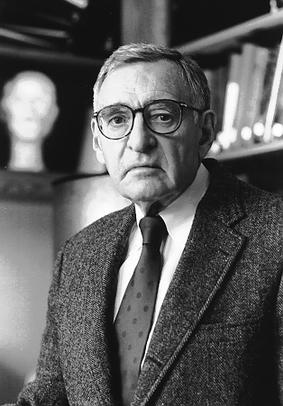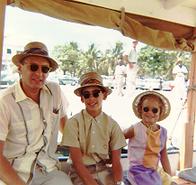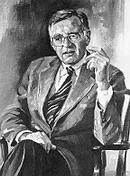Nurturing came naturally for Children's Hospital creator

Dr. David Karzon

Dr. David Karzon has always made time for family, such as this outing to Key West, Fla. in 1961 with his two children, David Jr. and Elizabeth

For his work at VUMC, Dr. David Karzon was honored in 1986 with a portrait and the establishment of the David T. Karzon Chair in Pediatrics.
He's a "very private" person, keeping much of his personal life out of the spotlight.
But Dr. David T. Karzon, former chairman of Pediatrics and now professor of Pediatrics, Emeritus, acknowledges – in a modest way – that to many he is the founding father of VUMC Children's Hospital, one who's spent more than 25 years at Vanderbilt developing programs to help sick children.
Karzon was born in New York City in July 1920, the youngest of four children. He spent his childhood and adolescent years in the Big Apple and Connecticut, where he first developed an interest in the natural world around him.
"It was the first place where I saw the outdoors readily. I collected all kinds of creatures and built houses and pens for them as pets. I remember particularly having a lot of turtles, and I had mice, rodents and squirrels as well as rabbits. I also raised fish."
And he remembers that his mother "tolerated well" his love and interest in nature. He grew up in a nurturing family.
"As long as I didn't ruin the house or usurp the bathroom with creatures, she would let me keep the animals."
Karzon went to a science high school in New York City, graduated in 1936 and headed to Yale for pre-medical studies.
He enjoyed it, but wasn't totally satisfied. About that time, his older brother stepped in.
"He told me about a new discipline at Ohio State University, where he was studying veterinary medicine. It was called Wildlife Conservation in the College of Agriculture. I transferred to Ohio State for my sophomore year. I had a wonderful time there.
"I was dealing with animals and plants and environments that were associated with farming and forestry practices. I learned a great deal about botany, fauna, geology, soils and climatology."
Karzon was heading toward his Ph.D. His goal was to become an investigator and teacher, spending his life studying "all the things that make up the environment."
But during his master's program, he began to have a change of heart. A desire to do more fundamental research started to take hold. So, Karzon made a career u-turn. He went back to medicine.
"I decided that the most fulfilling biological science to be learned would pertain to people. I wanted to do research and teach, and medical school could prepare me for that."
Karzon was accepted into several medical schools. Ultimately, he chose Johns Hopkins. Then fate stepped in, in the form of December 7, 1941 – the Japanese attack on Pearl Harbor. Karzon was drafted and became a private first-class in the U.S. Army.
"We were put in an accelerated medical school program with no vacations, so we completed the four-year program in 36 months."
He finished medical school in 1944 and did a residency at Johns Hopkins in internal medicine on the Osler service. From there, Karzon went into service as a "soldier" doctor, a first lieutenant commanding a medical company.
And it was then he married his sweetheart of five months, Allaire Urban. While Karzon was stationed in Maryland, Allaire finished law school at Yale.
Karzon continued in the Army for two years. Then he returned to Johns Hopkins for more training and it was during this time that his interest in infectious diseases was sparked.
"I elected an assignment in the infectious diseases hospital. At that time, patients with infectious diseases were isolated from the rest of the population. This was in the early days of antibiotics and vaccines were not widely used.
"It was intriguing and disturbing to me. There were viruses, bacteria and fungi which made people very sick, and many of them, both children and adults, died. There were epidemics of polio, diphtheria and pertussis. We took care of about 600 cases of diphtheria and about 400 polio patients that first year."
Karzon's interest in the health of children began about this time too.
"About half of the people in the hospital were children. I had to take care of the children and found I enjoyed it.
"I liked their honesty. When they are mad, they may kick you. But I also learned that by dealing with children with patience, and communicating at their level of understanding, they can be cooperative and brave. They were pure people and I liked them very much.
"Many of them got desperately sick, or had severe residual handicaps, and some died. I thought that a lot could be done for them."
In 1950, Karzon moved on to Cornell to study pediatrics for two years – a move which allowed Allaire to establish a law career in New York City.
In 1952, Karzon was ready to teach. He accepted a faculty appointment at the Children's Hospital of the University of Buffalo, creating a new infectious disease division.
"An NIH (National Institutes of Health) grant enabled the construction of a wing for viral studies. In addition, I enjoyed a joint teaching and research role in the University's Department of Bacteriology and Immunology."
The Karzon family was now larger. A son, David Jr. (Deke), had been born in Maryland in 1950, and a daughter, Elizabeth, was born in Buffalo in 1955.
For the next 16 years, Karzon continued his work in Buffalo, New York. But, by 1968, some changes were coming. Karzon was offered the chairmanship of the department of Pediatrics at VUMC.
"I had been looking at chairs at the time. I had had several offers, but wasn't quite satisfied with anything I saw.
"Then I got a call from Vanderbilt. I liked its style. I liked the people. I liked the way they were doing things. It was a relatively small school, but it was intellectually very strong. There was a lot of scientific talent and they were doing good clinical work.
"I saw a fine environment with a lot of opportunity, but a lot had to be done."
On arrival at Vanderbilt, Karzon set to work developing an intellectual framework for a children's hospital.
"We needed an environment for children that didn't exist. Children were in hospital wards, treated the way everyone else was; for example, getting the same food, having the same visiting hours and the same routine. That was no way to care for children.
"We had to get permission from both the university and the medical school. They were both puzzled and probably didn't fully understand what I was talking about. But they said yes.
"I'm certain, in retrospect, that no one could have envisioned the magnitude and complexity of the simple idea. Importantly, permission was granted to create a community-based Children's Hospital Board and also to establish a Children's Fund."
Karzon started by setting aside and establishing a Children's Hospital area in the old hospital, changing its look by creating a home-like, family-oriented atmosphere.
Early on, Karzon found space and set up a small playroom. Changes were also made in the food service.
"We developed a new child-oriented menu more suitable for toddlers and children with a lot less waste in the kitchen," Karzon said.
When the new Vanderbilt University Hospital was being planned in 1980, Karzon was among the first in line to pick a spot in the new building for his continuing dream. He selected a potential location on the fifth floor because it had a central outdoor area that was actually a roof at the base of the two hospital towers.
"I looked at the plans and picked out a floor and asked what was going to be done with that big hole in the middle of the fifth floor? They said, 'Oh, that is just the gravel roof at the base of the two bed towers.' And I asked, 'You're not going to do anything with that? How about making a play area, get it tiled and put swings, play equipment and a garden there?'"
Karzon then asked for an area of the fifth floor fronting on the garden to provide an indoor play area. A spacious playroom was developed and a full-time play therapist with professional and volunteer staff was recruited. During hospitalization, the play program has served as a sanctuary for both children and parents.
Karzon also pushed for a readily identifiable, separate entrance to Children's Hospital. That materialized in the form of a designated Children's Hospital elevator.
More firsts for Children's Hospital followed. Karzon utilized sleeper chairs and introduced flexible visiting hours. Parents were allowed to stay with their sick children around-the-clock.
Karzon credits much of the success of Children's Hospital to help from the Middle Tennessee community.
"Nashville and Middle Tennessee were splendidly supportive. Community organizations such as the Junior League and many other groups were leaders in our development. We are fortunate indeed.
"Without true community commitment and belief that the product is of value to them, their children, their grandchildren and their neighbors, it would not have been possible."
In addition to the extensive initiatives in the hospital environment, the community involvement and fund-raising initiatives, the development of excellence in pediatric care was a dominant theme for Karzon. He redesigned faculty structure, creating formal divisions and giving more leadership roles to the various pediatric sub-specialties.
"My task was to recruit division heads who would excel in clinical care, teaching and investigation and would be competitive for NIH funding. It was hard at first, but slowly, the department became more attractive and it was easier. Faculty in other departments of the medical center helped considerably in recruiting first-rate pediatric talent.
"Neonatology was the only sub-specialty in place prior to the advent of the Children's Hospital. Some 14 divisions were subsequently established and the number continues to rise."
In 1986, after 18 years as chairman of the department of Pediatrics, Karzon stepped down.
He continued full-time at VUMC as professor of Pediatrics, working in research until 1994. Now he consults with faculty and students in infectious disease at Vanderbilt, and serves as an advisor to governmental agencies in Washington, D.C., in areas of vaccine development and policy.
Karzon and Allaire, professor of Law, Emerita, split their time now between Tucson, Arizona, and Nashville.
The couple celebrated their 50th wedding anniversary this past year and often visit their two grown children and grandchildren.
"I am very active physically, which is something I didn't do very well before.
And Karzon is back to his first love, enjoying nature.
"My biggest hobby is learning the flora and fauna and the life of the desert. It's exciting. I never lived in the desert before and it's very rich in life of all sorts."
Looking back, Karzon modestly admits to feeling successful in his career.
"I wanted children to be treated in a special area and with special care and we have that. Our Children's Hospital is capable of being more efficient than many because we integrated into the overall rich resources of a university hospital and medical school."
But he won't take all the credit for it.
"I did get a lot of help through the years. VUMC and the community were open to change. I have to give the university structure and medical school leadership the credit for saying 'Yes, let's go with it.' "
Karzon says he is happy, and busy in retirement.
"We are trying to do all the things that we never had or chose to have time to do before. We have a lot of projects and visitors and we travel a lot.
"My work project now is attracting new species of birds and if they appear I am just on top of the world. That is happiness to me, now."













